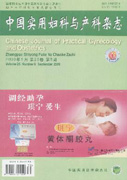Abstract:In recent years,the number of pregnant women at advanced maternal age has increased very quickly,followed by the increase of maternal and neonatal morbidity and mortality.It is the key to guaranteeing these womens health,decreasing incidence of birth defects and improving obstetrical quality to perfect pre-pregnant consultation and evaluate the risk in gestation period,strengthen the screening and diagnosis of birth defects in early pregnancy,strengthen the management of catastrophe placenta previa and vaginal birth after cesarean section(VBAC)in whole pregnancy.

